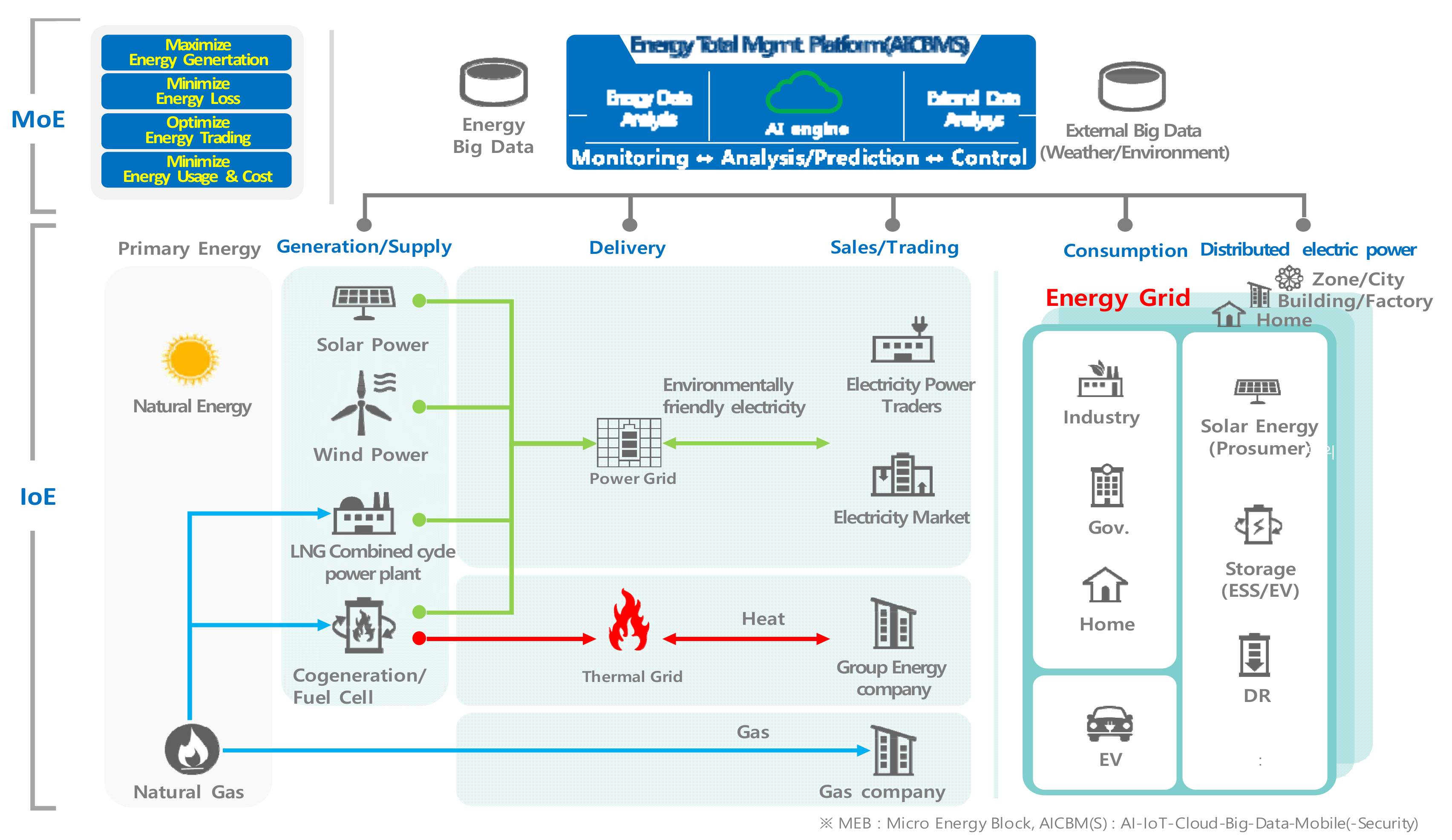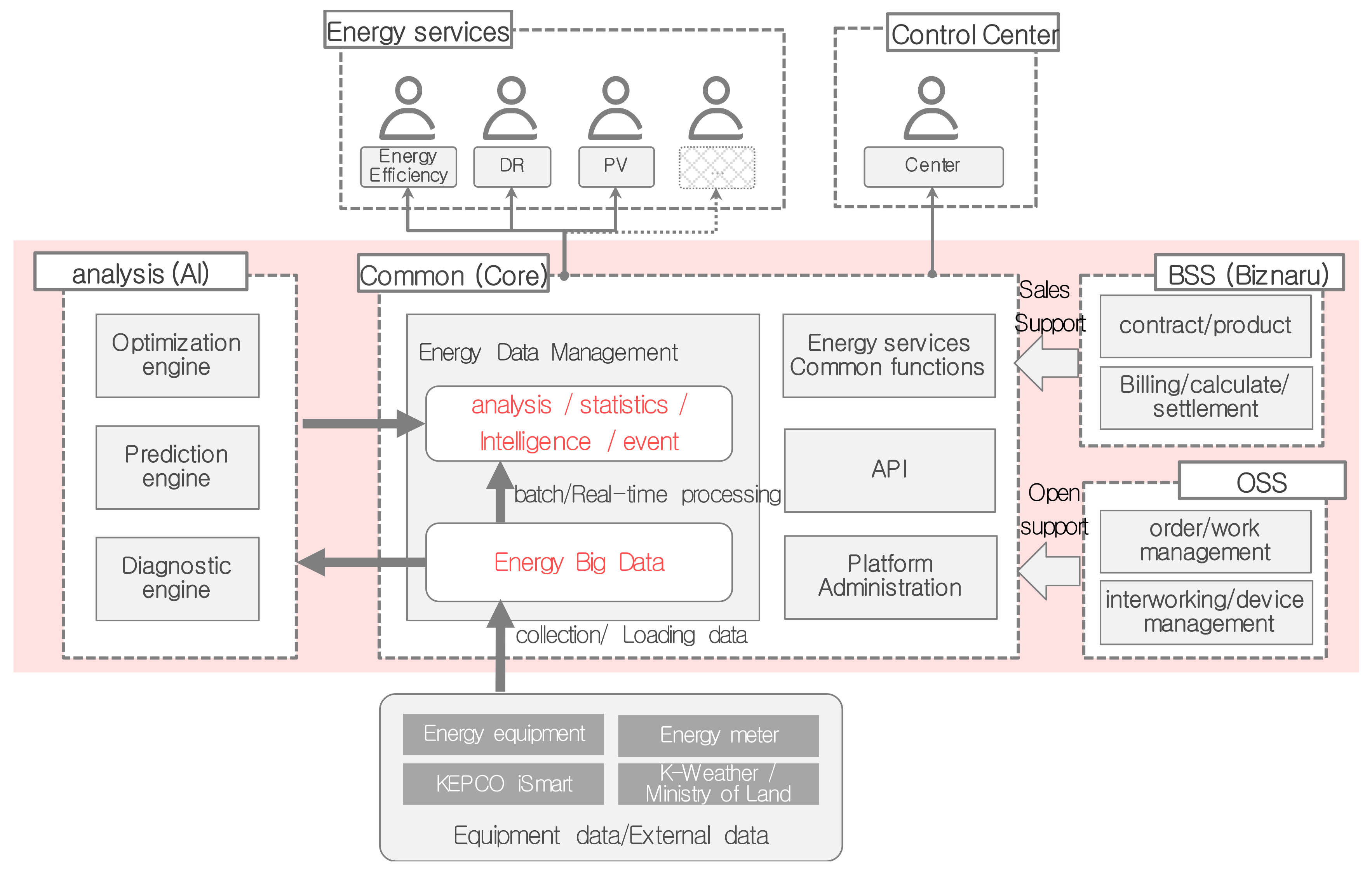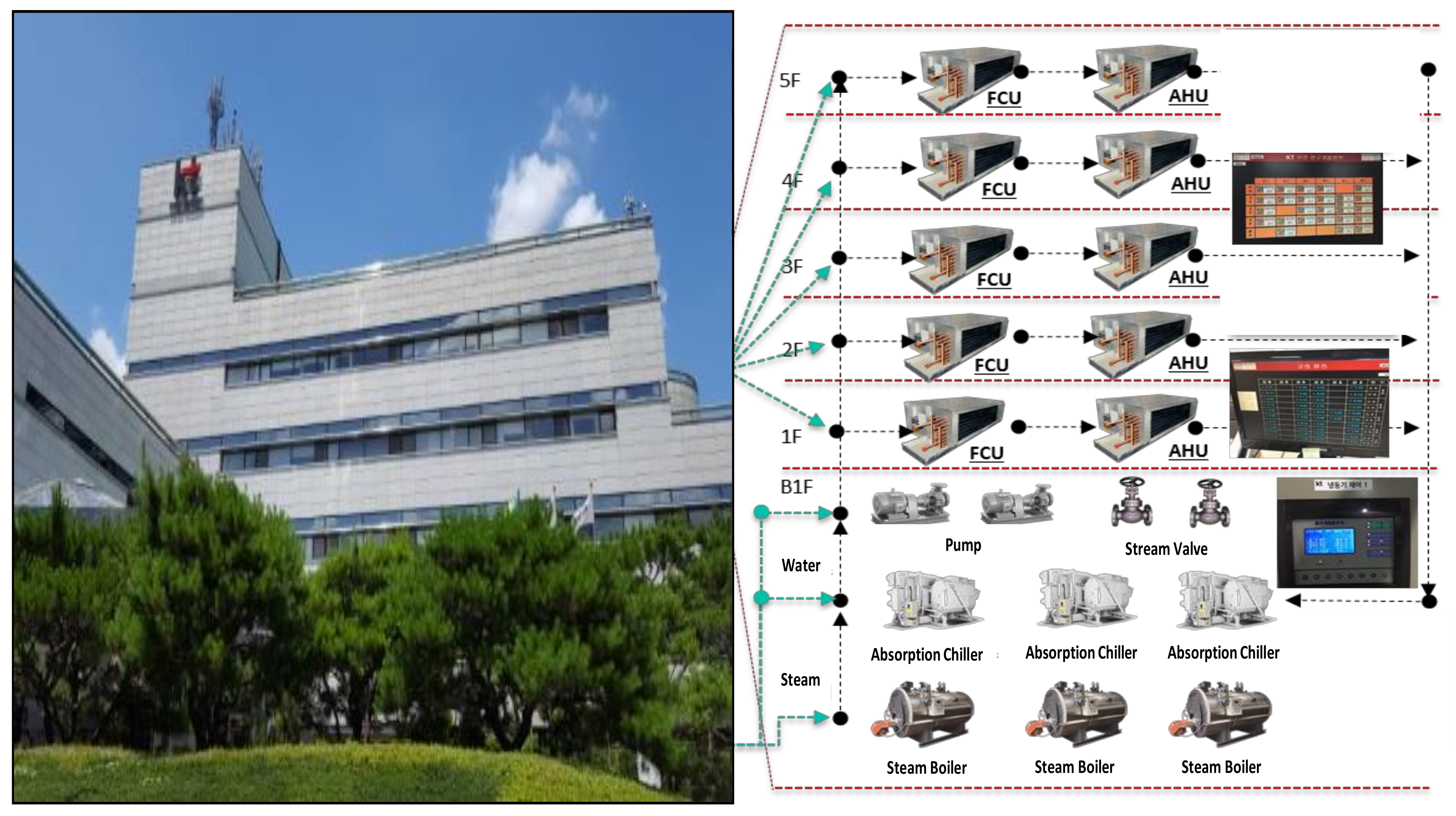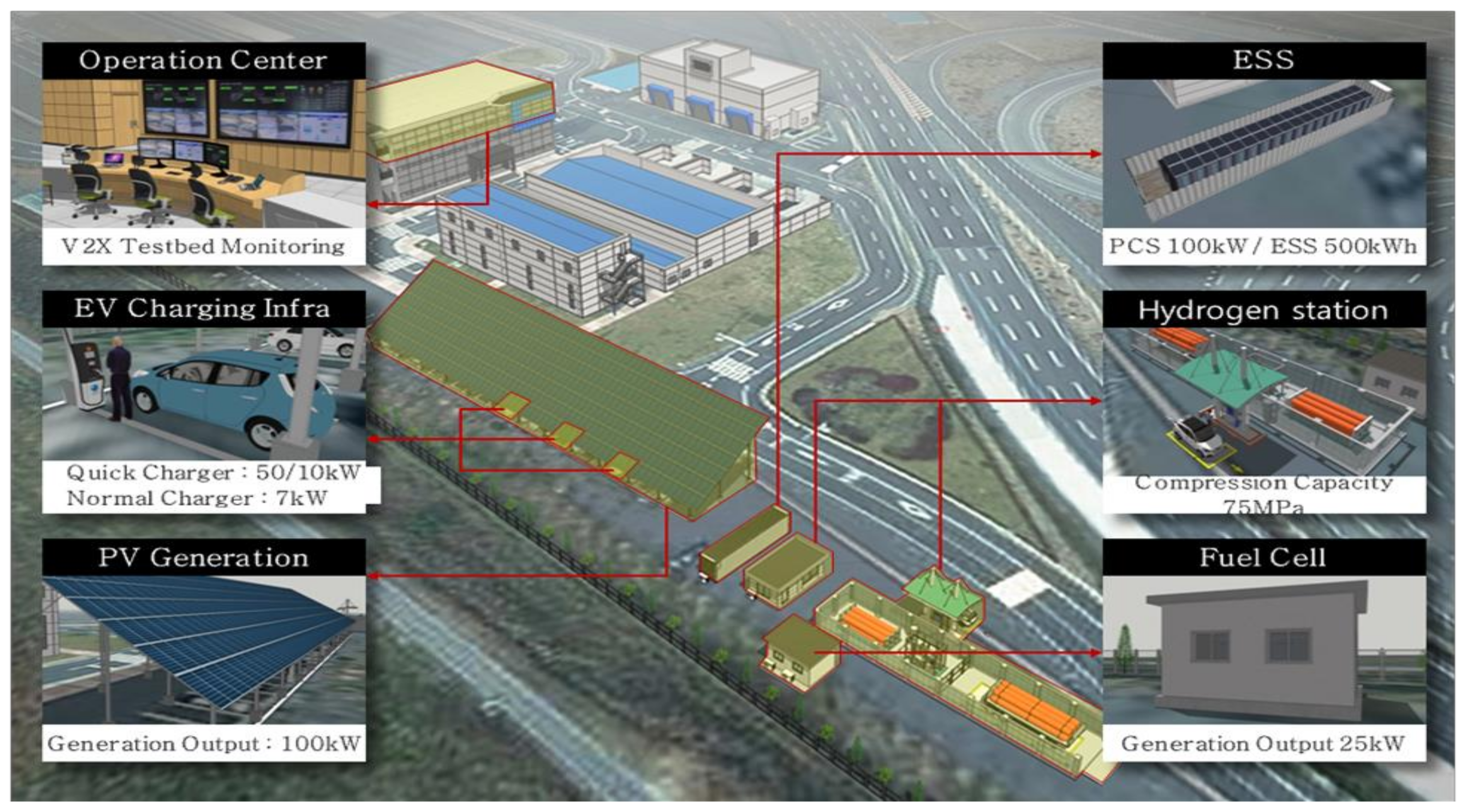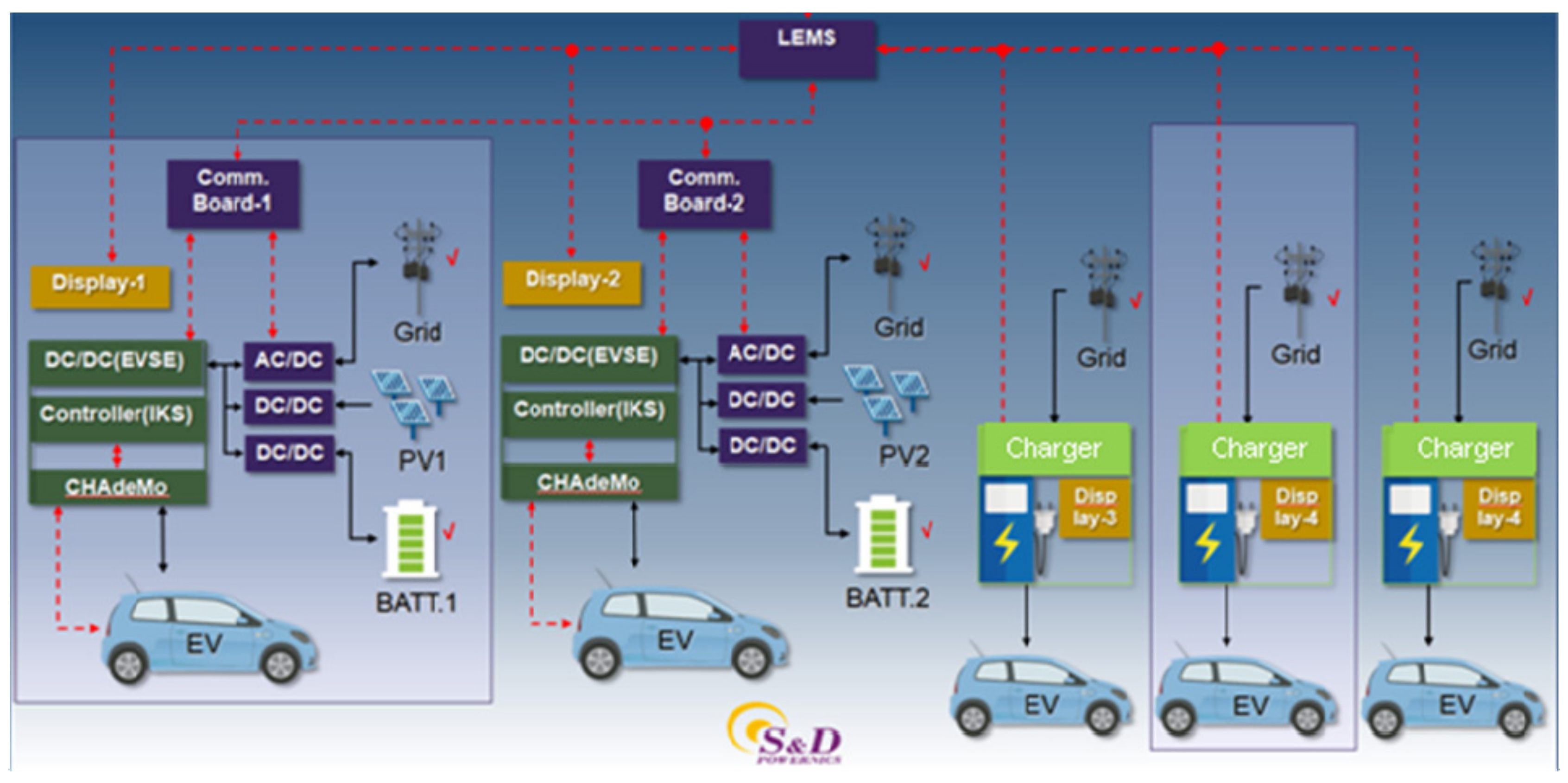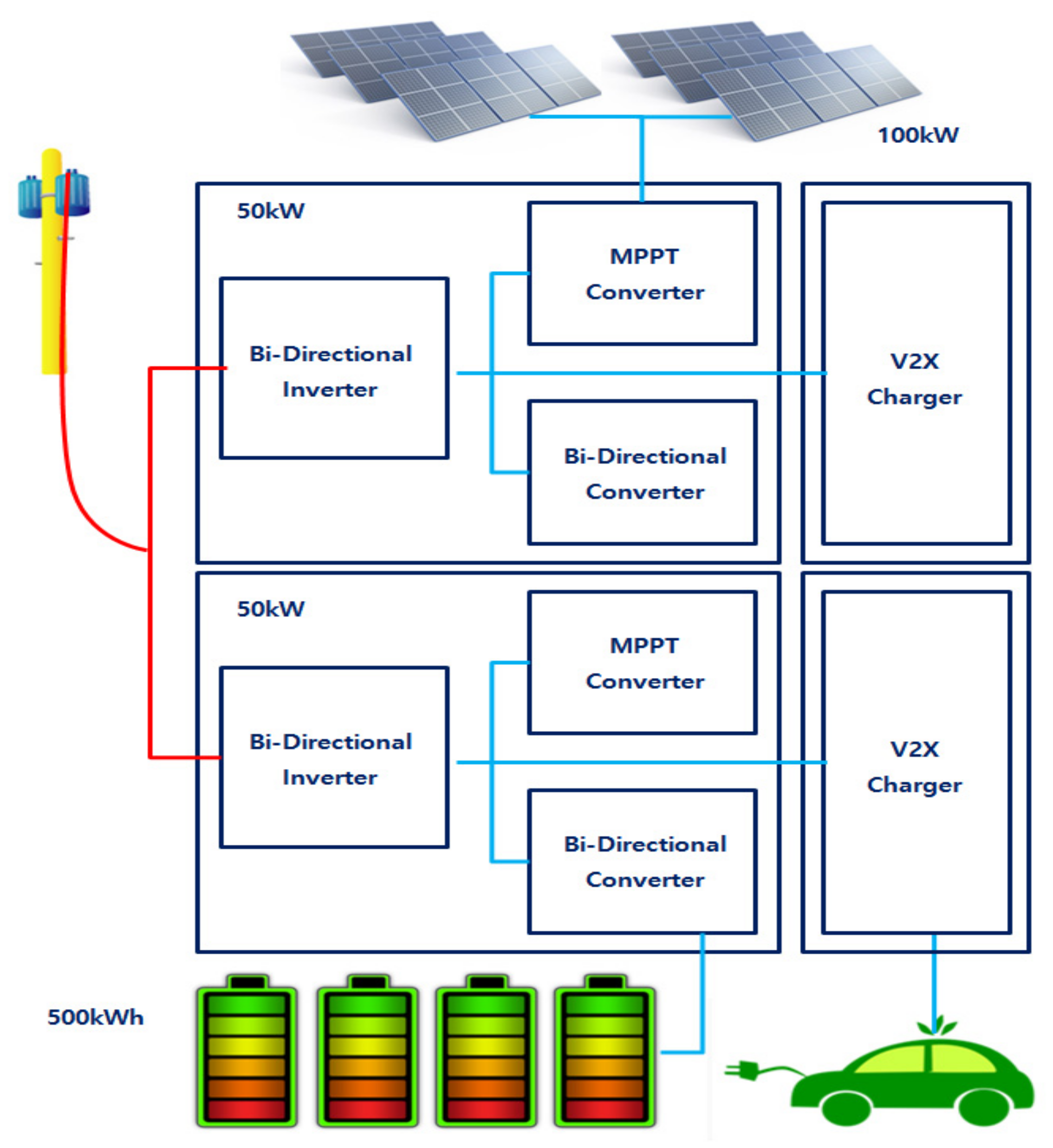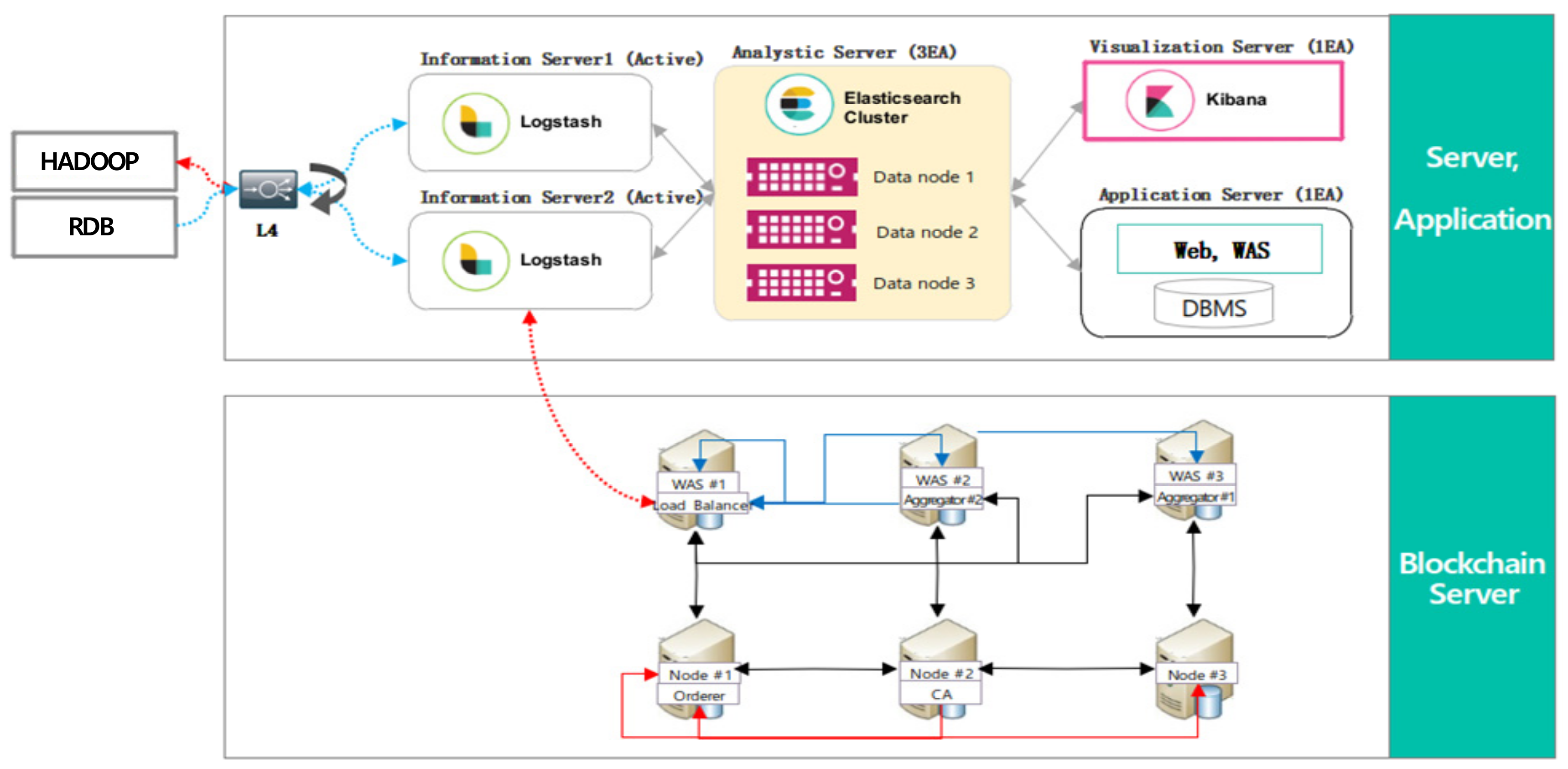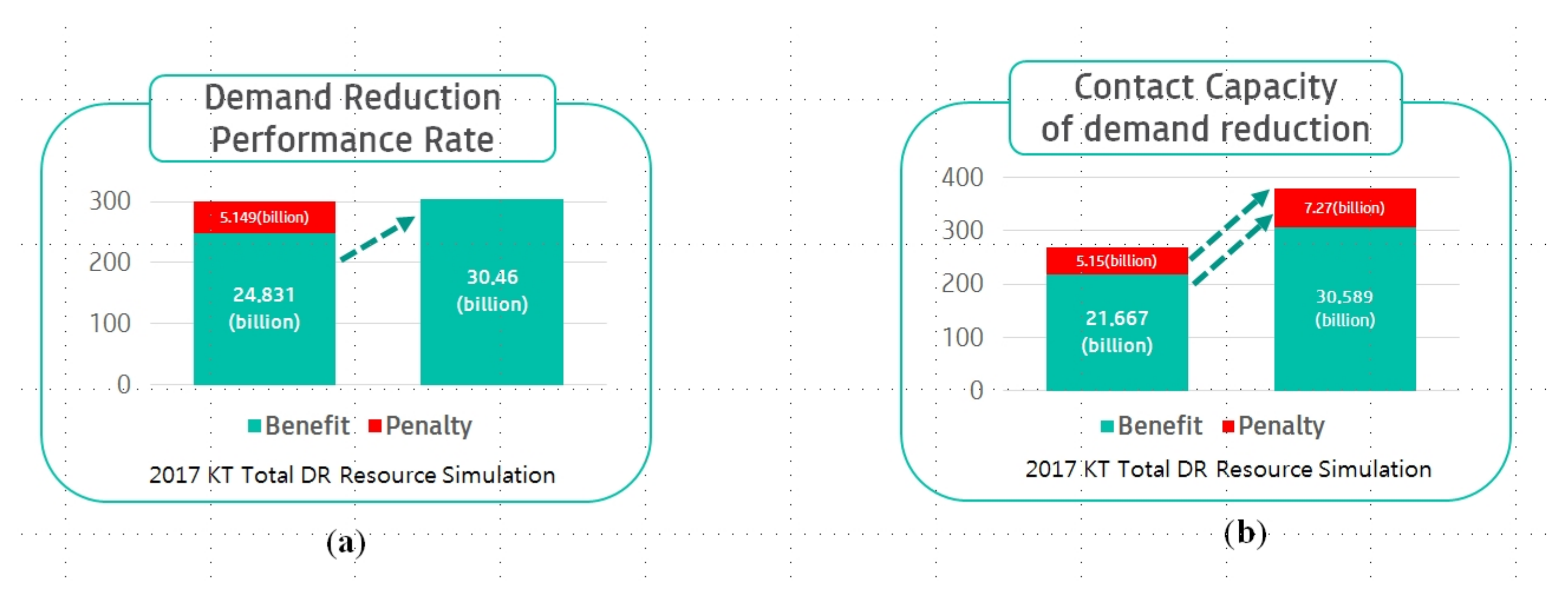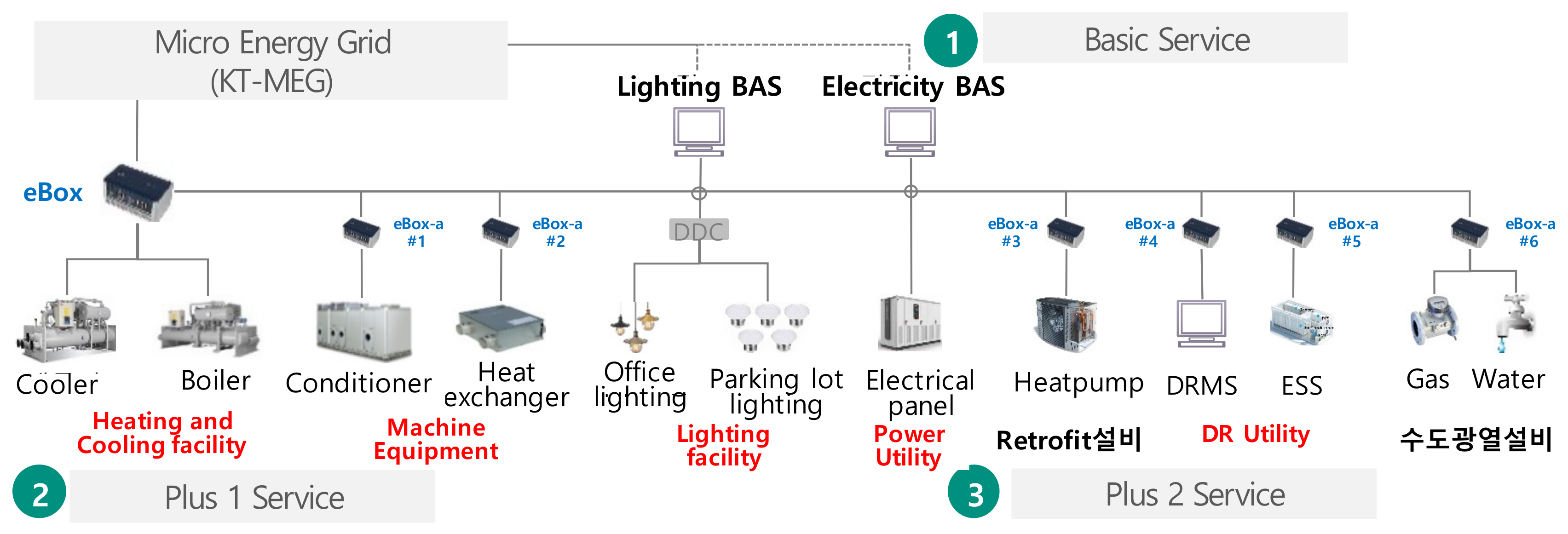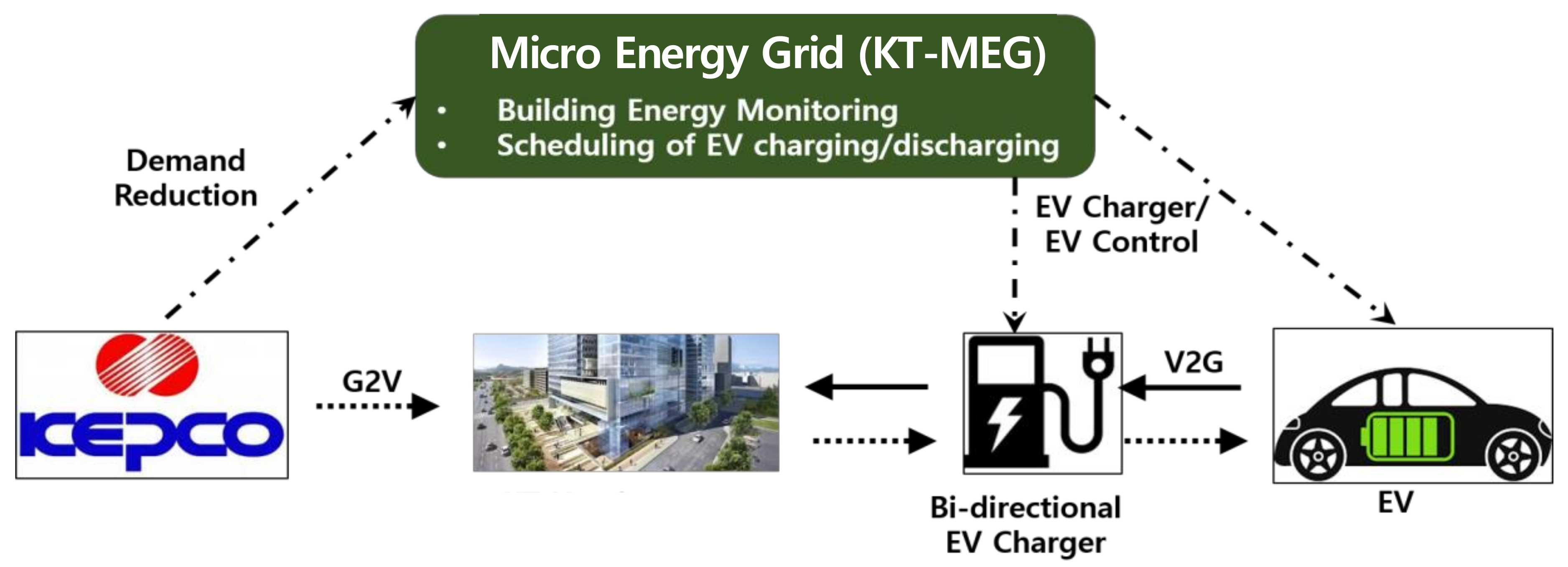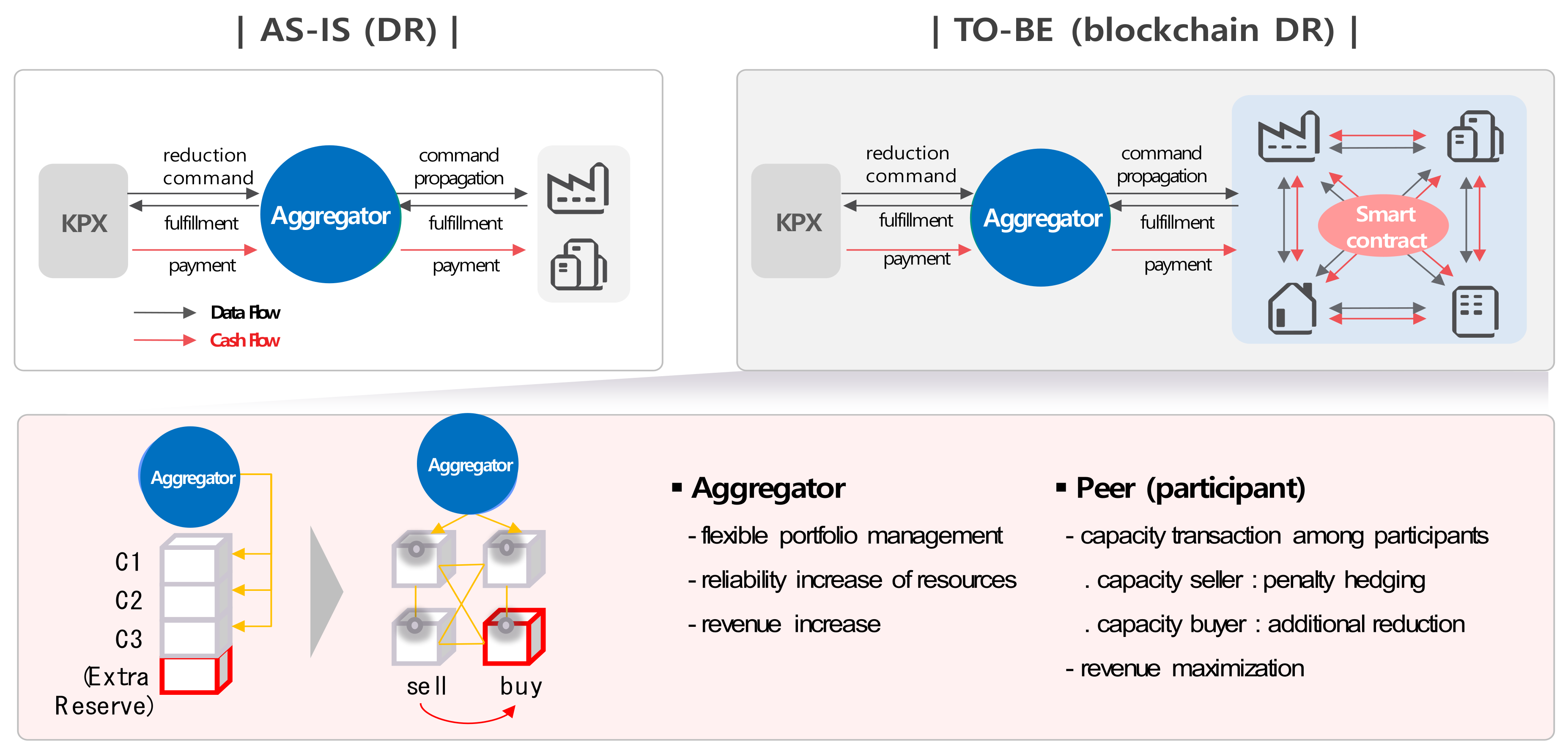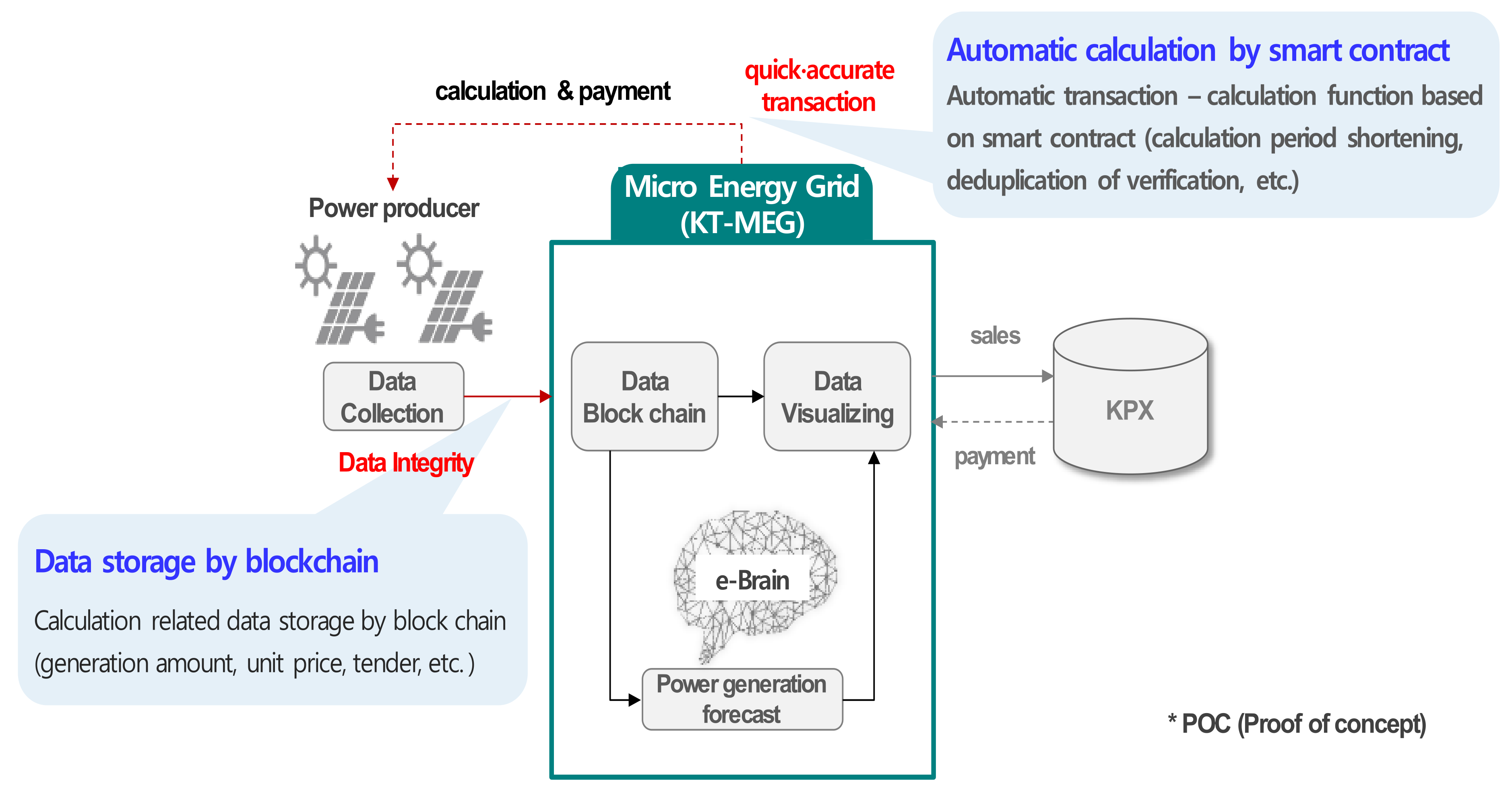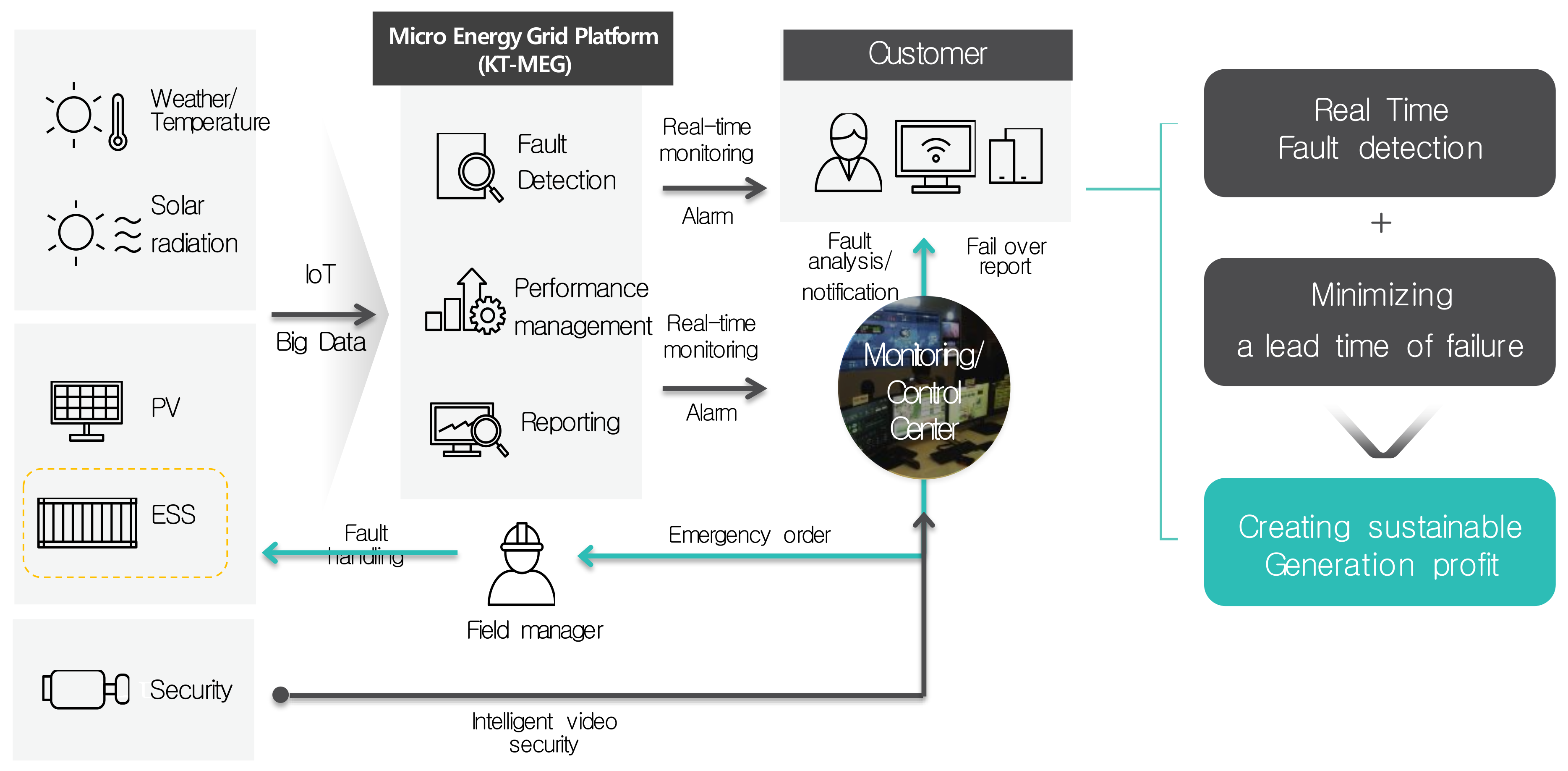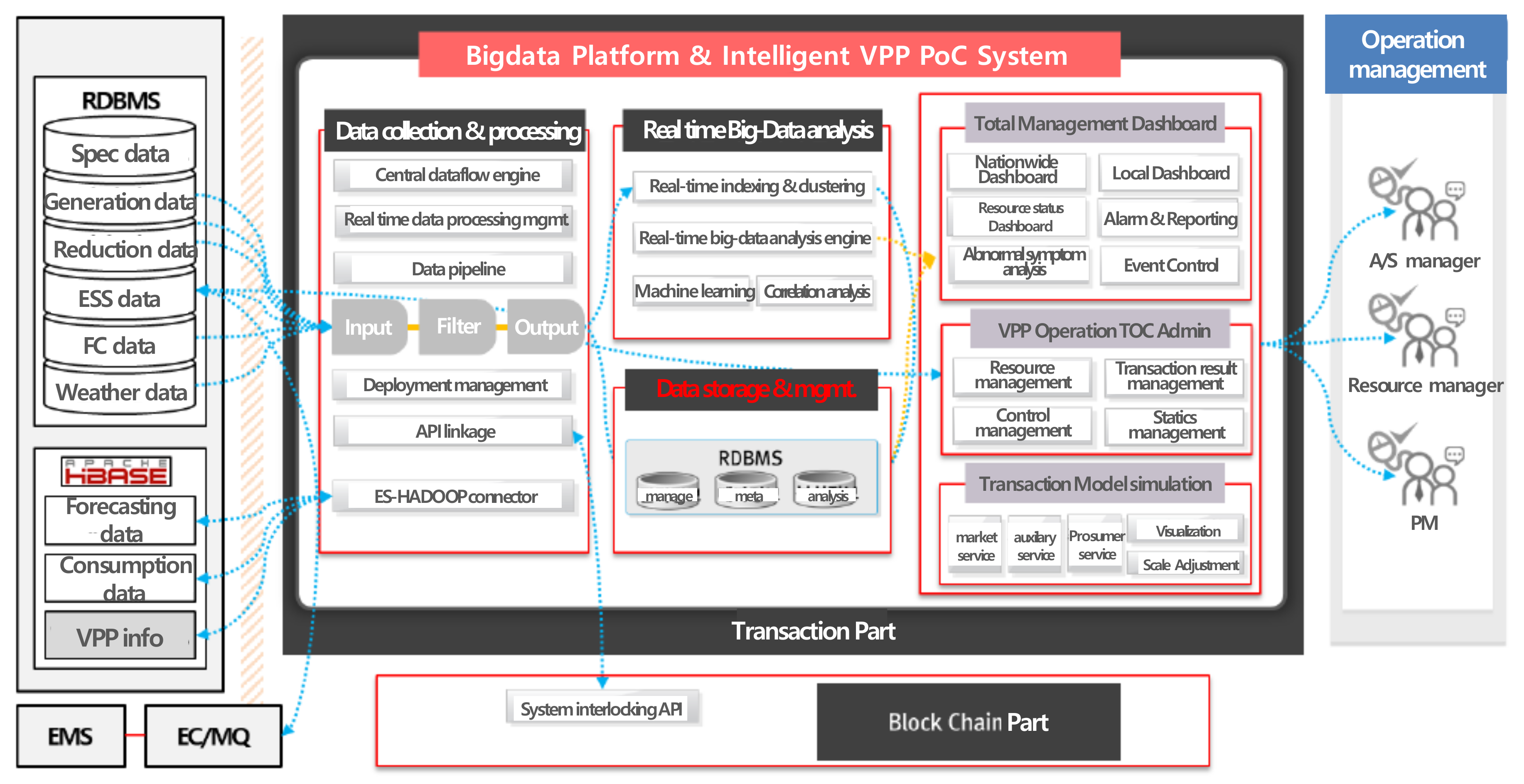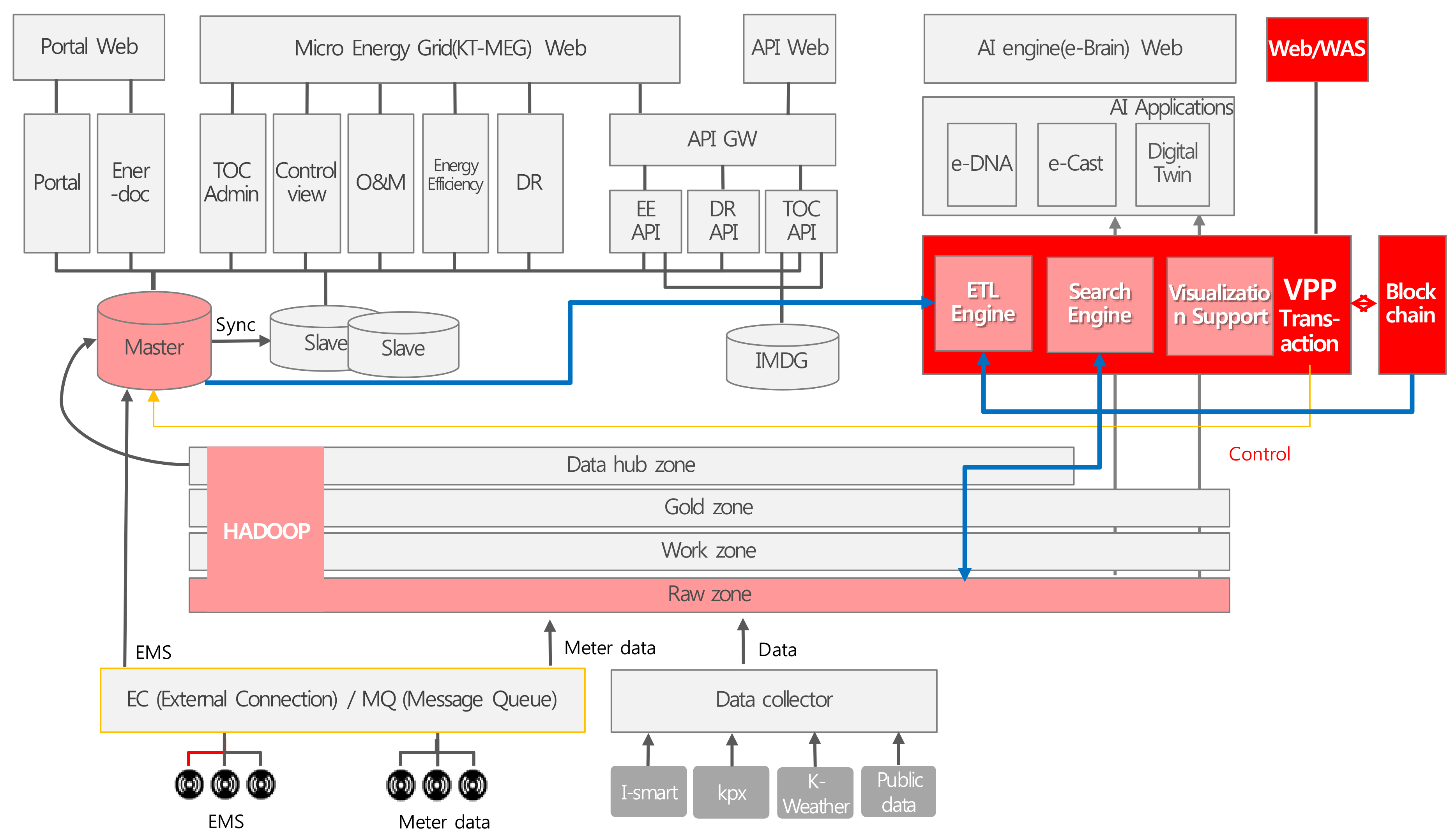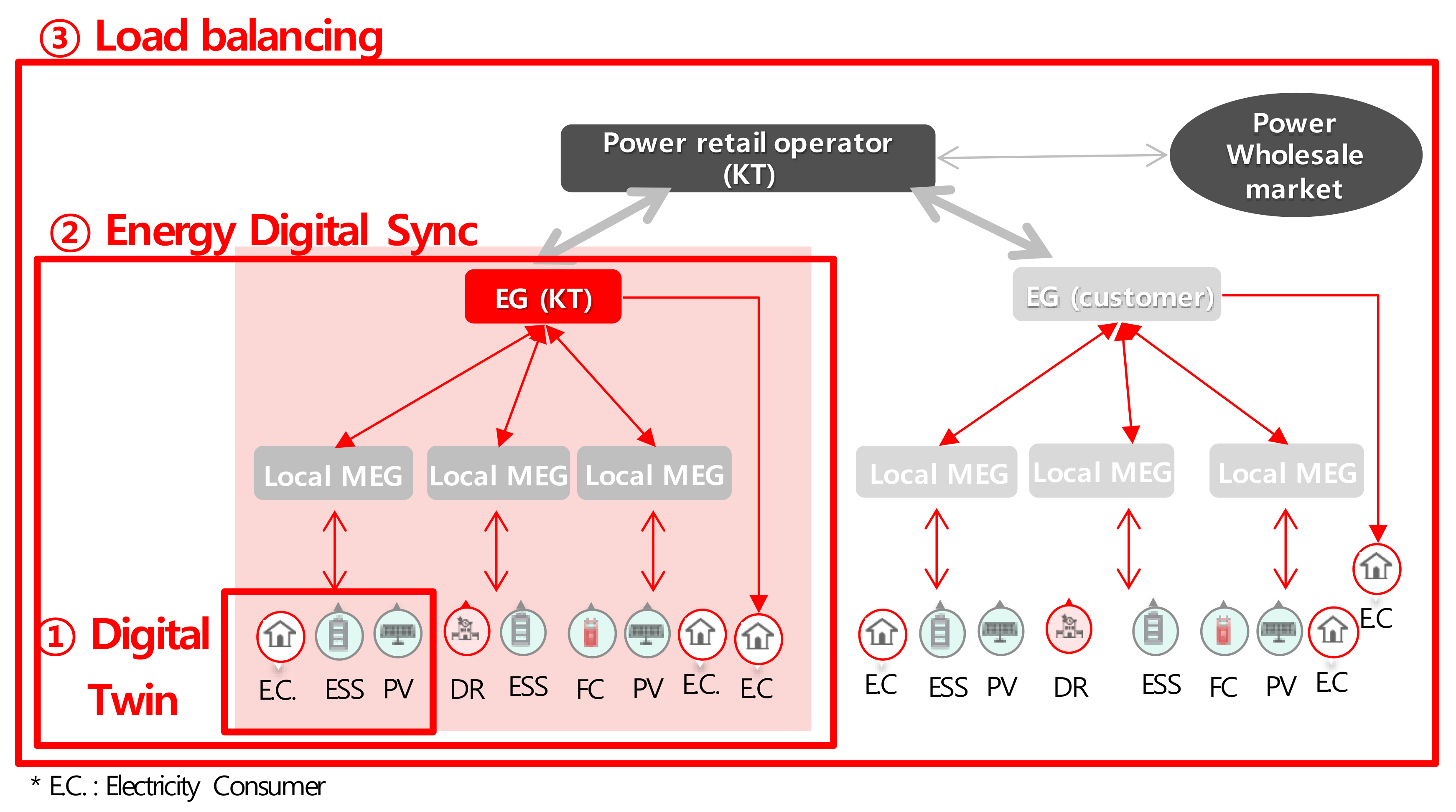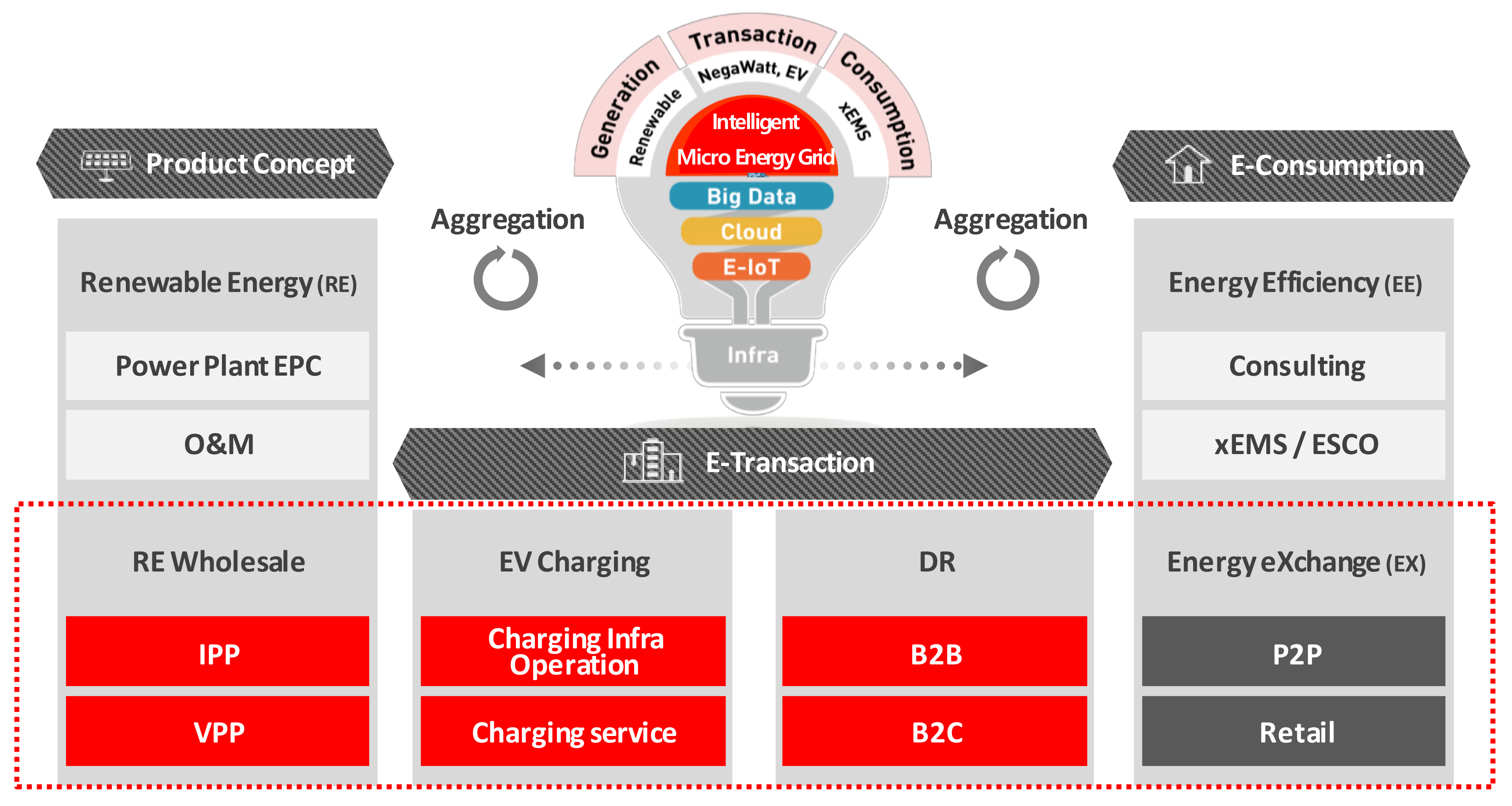1. Introduction
Recently, there has been intense competition among global companies to take the lead in the field of fifth-generation mobile (5G) technology, which is considered as a major future source of revenue. The 5G network will be widely deployed as a basic infrastructure for hyperconnected smart devices, and it will eventually evolve into a new platform called 5GaaP (5G as a platform). Furthermore, 5G is expected to reach beyond the ultrawideband network to support the creation of innovative services in combination with existing technologies, such as the Internet of Things (IoT), cloud, big data, artificial intelligence, and blockchain. The energy industry is likewise expected to experience great changes owing to 5G technology.
5G is an innovative next-generation platform that will help address immediate social issues such as climate change, disaster safety and traffic congestion, as well as accelerate the realization of the concept of intelligent virtual power plants in the energy sector. Future energy in the 5G era will create an ‘Intelligent Virtual Power Plant’ that can maximize the diversification of resources and integrate energy consumption, production and trade.
5G technology in Korea can be applied to real-time energy trading between the production and consumption resources, demand management for factories and buildings, and distributed resource management for the whole country, which is spreading rapidly with the national energy conversion policy. Thereby, the analysis and prediction of patterns in energy production and consumption employing an artificial intelligence engine with available real-time big data become a possibility. The digital twin technology combined with 5G technology enables system operators to conduct optimal operation and control of virtual power plants through the visual simulation of energy production and consumption, consequently balancing energy production and consumption within the virtual power plant. Furthermore, secure energy trading between the energy producer and consumer can be achieved in real-time by employing a blockchain technology.
Governments and energy suppliers across the globe are increasingly recognizing advantages of smart energy systems with renewable energy sources such as solar and wind. However, according to the Korea Energy Agency, only 6.61% of South Korea’s electricity has been generated by renewable energy sources as of May 2017, due to strict regulations in the energy market. Until 2015, the generation and supply of Korea’s electricity had been the sole responsibility of Korea Electric Power Corporation (KEPCO), which held a monopoly on the entire state grid. To foster the energy industry, the government introduced a phased deregulation plan of the energy market, making it possible for private entities to enter and compete. This allowed Korea Telecom (KT) to enter the market with its core competencies in information and communication technology (ICT). KT considered that its extensive experience in the management of the nationwide network of multimillion account scale billing platform capabilities, and of new technologies such as artificial intelligence and the internet of things (IoT), would be a tremendous asset contributing to the reform of the energy industry. The future energy industry employing ICT is bound to create business models that reach beyond the mere supply of energy. As an example, advanced ICTs, including big data, AI, and blockchain, represent promising solutions to resolve the problem of chronic supply shortages in the electric power market.
In the present study, we first introduce the architecture of the intelligent microgrid energy management platform along with the e-Brain and commercial services running on the platform, in terms of energy efficiency, renewable/distributed energy resources, and energy trading. Subsequently, we provide the testbed results from the commercial services performed. Finally, we propose new business models and solutions developed for the intelligent micro energy grid.
There is a considerable amount of recent literature addressing the subject of the IoT, smart grid, and micro energy grid service and architecture. A literature review concerning these technologies, platforms, and models related to our work is broadly categorized into the eight following areas:
5G Technology and Business Model: The advantage of 5G cellular systems is that they are simultaneously truly ubiquitous, reliable, scalable, and cost-efficient. This was considered as a potential key driver for the global IoT [
1]. Most relevant 5G uses that require ultralow latency comprise the integration of healthcare, industrial processes, transport services, or entertainment applications. Likewise, smart energy represents an important use for 5G technology; however, it is left out of this study due to the lack of data sources [
2].
IoT/Big Data Architecture: The development of big data and the IoT is rapidly accelerating and influencing all areas of technology and business [
3]. The big data revolution promises to transform how we live, work, and think by employing optimization processes, empowering insight discovery, and improving decision-making [
4].
Micro Energy Grid Architecture: A micro energy grid reference model was developed to enable interoperability between devices or applications operated in a micro energy grid environment in [
5]. The authors realized efficient energy generation, consumption, and distribution by optimizing the use of different energy resources like gas, heat, and electricity. Yamzaki et al. [
6] proposed an approach for the data processing infrastructure in next generation smart grid. This approach would become more complex with heterogeneous factor, such as renewable energy resources, electric vehicles (EVs), microgrids, smart meters, demand-side energy management systems, demand response (DR), and dynamic pricing. The study also proposed a scheme and data processing framework with the analytic infrastructure for a future smart grid.
Case Study of Micro Energy Grid: Akshay et al. [
7] presented the realization of an operational smart renewable energy microgrid set up in a remote village and proposed the implementation of smart microgrid systems that perform energy monitoring, grid communication, energy auditing, and power management, all of which are sufficiently defined and designed for multifamily dwellings or suburban areas. Mei et al. [
8] introduced concepts and design principles of a smart micro energy grid (MEG) employed for the accommodation of existing microgrids, distributed poly-generation systems, energy storage facilities, and associated energy distribution infrastructures. The authors presented a prototype of China’s first conceptual solar-based smart MEG, established in Qinghai University. In addition, Hwang et al. [
9] presented a case example where remote places, such as small villages or islands, are supplied with sustainable power using renewable energies such as photovoltaic and wind power. A smart grid system with a photovoltaic (PV) panel, wind turbine (WT), and energy storage system (ESS) was demonstrated in the study. Moreover, power supply monitoring and automatic operating systems were implemented to monitor and cope with unexpected situations imposed on the system.
Blockchain for Energy Trade: Luo et al. [
10] proposed a two-layer energy trading framework, based on a multiagent system (MAS) and blockchain. In the first layer, a mechanism employing the MAS was proposed to allow prosumers to group and enter into reciprocal agreements on energy trading. In the second layer, a blockchain-based mechanism was designed to provide security for the transactions conducted in the first layer. Aitzhan et al. [
11] built a combination of blockchain technology, multi-signatures, and anonymous encrypted message propagation streams into a framework that allows customers within the smart grid to negotiate energy trading securely and anonymously. Energy trade scenarios were modeled and simulated, and security and performance analysis of their framework was performed.
Virtual Power Plant (VPP) Service: Several studies in the literature presented optimization frameworks for the optimal scheduling control of distributed energy resources (DERs) in the VPP, with the aim to reduce generation cost and power losses while increasing their reliability using various techniques. Yang et al. [
12] proposed a VPP optimal dispatch model to maximize the use of DER in the electric power network based on the extreme learning machine (ELM). Similarly, Abdolrasol et al. [
13] developed a model for the optimal scheduling control of VPP employing the binary backtracking search algorithm (BBSA), which ensures the achievement of the most optimal schedule for the selected objectives. Similarly, Camal et al. [
14] proposed an optimal dispatch of DER for a VPP, but here the authors employed the quantile regression forest model to forecast the VPP production. In that study, wind and photovoltaic power plants were technically able to provide ancillary services. More recently, the primal-dual-type method was employed to the time-varying optimization for the real-time control of a VPP that could adjust the output of the DERs to maintain quality in the power network and achieve the objectives of both the customer and the utility company [
15].
Vehicle-to-Grid (V2G) Service: Zeng et al. [
16] developed a demand response management in the V2G system by formulating a two-level auction model for the sale of energy. At the first level, EVs and aggregators (charging and discharging stations) in the power network perform an auction process, while at the second level, the aggregators and electric power network perform another auction process. Recently, Yu et al. [
17] proposed a development of the V2G system model for the demand response management that considers mobile EVs as flexible energy storage and transporters, which later lead to the balance of power demand among different regions in the electric power network. Moreover, a centralized optimization framework based on mixed-integer linear programming (MILP) for the residential DR program considering EVs with vehicle-to-home (V2H), vehicle-to-neighbor (V2N), and vehicle-to-grid (V2G) capabilities [
18]. Similar to Anese et al. [
15], Zhong et al. [
19] presented a demand response (DR) model of the V2G system that considers the stability of the DR algorithm, which is robust to the mobile manner of EVs in the electric power network. Last but not least, Khah et al. [
20] introduced a stochastic programming-based optimization framework for the optimal behavior of EV parking lots, which participate in both the incentive-based and price-based DR programs.
Smart Grid/Microgrid Business Model: Menniti et al. [
21] introduced basic energy services that can be commonly used by application developers. In this context, the authors proposed a new market platform to coordinate the energy exchange among several micro smart grids aggregated in a virtual energy district. Numerical results from Matlab/Simulink environment were presented to validate the proposed platform. A smart microgrid framework for rural electrification with a methodology defining the important criteria for microgrid project implementation while considering sustainability was presented [
22]. Then, two business models of this microgrid framework were proposed for a case study in Chile. Vatanparvar et al. [
23] developed a rule-based business model for the microgrid, where the design space exploration methodology was used to achieve benefits for all stakeholders including the utility company, aggregators, and prosumers.
Nevertheless, the aforementioned studies presented the framework and algorithms belonging only to their own individual categories described above. None of the previous works has presented and developed a universal system, platform, and business model for a smart micro energy grid that considers (1) the integrated architecture and business model employing advanced technologies (e.g., IoT, big data, AI, and blockchain) and new energy services (e.g., intelligent VPP operator and V2G) and (2) a more realistic testbed to quantify the performance of the proposed microgrid systems and services. The main contributions of the present study are summarized as follows.
Open micro energy grid platform and smart energy business cases: Based on the intelligent management of energy (MoE), which optimizes energy production and consumption by employing energy ICT technology, we introduce the open architecture and platform, which performs the optimized operations of smart microgrids with renewable and distributed energy resources. We also present energy management solutions, including the energy efficiency management service, distributed energy resource service, and energy trade service.
Testbeds for smart micro energy grid services: We constructed three different testbeds to evaluate the performance of energy efficiency in a building environment, Vehicle to Everything (V2X), and blockchain-based DR. We subsequently report the testbed results and demonstrate the effectiveness of the aforementioned business models and services.
Next applications for the intelligent micro energy grid: We propose four types of business models for the intelligent future micro energy grid: (i) energy robot-management operation business model, (ii) EV-based demand response, (iii) blockchain technology for energy trading, and (iv) service-oriented business model. Furthermore, we present a new business model for the intelligent VPP, which is developed using promising technologies such as digital twin, energy digital sync, and load balancing.
The rest of this paper is organized as follows.
Section 2 introduces the open micro energy grid platform.
Section 3 describes the smart micro energy grid services. Testbeds of the hybrid micro energy gird are provided in
Section 4. The next intelligent energy applications for future micro energy grids are presented in
Section 5, followed by new business models for intelligent VPP in
Section 6. Finally,
Section 7 provides our conclusion and future perspectives.
2. Overview of Open Micro Energy Grid Platform
2.1. Concepts of Internet of Energy (IoE) and Management of Enegy (MoE)
IoT refers to a communication technology enabling exchange of information between people and things or mutually between things. Similarly to the concept of IoT, the Internet of Energy (IoE) implies the energy internet infrastructure where facilities associated with the production, transaction, and consumption of energy are interconnected and share information among each other to benefit both energy producers and consumers [
24]. Tony Seba, an author and futurist of the Energy Revolution 2030, noted that the energy internet, led by the state and public institutions, will completely destroy the existing industry and the energy industry, and that it will become a major source of data, in the form of big data and AI combined with ICT. Evidently, IoE will create new markets with entirely different service ranges and lead to the fourth industrial revolution of energy. The adoption of IoE is accompanied with concerns over how to foster its implementation to create new markets. IoE is often referred to as the energy rail network because it interconnects energy demand and supply in the new energy industry in the same manner of the rail network for other industries. Hence, IoE is necessary for the efficient management of real-time operations. Furthermore, if IoE is integrated with intelligent data analysis technology, such as big data analytics, it can improve the performance of the existing energy infrastructure.
The management of energy (MoE) refers to an integrated energy management platform with intelligent management concepts that collects data from the IoE, monitors the desired situation, and optimally controls the facilities connected to the IoE through various analysis and prediction methods. The MoE can lead to transaction optimization, distributed energy resource management, production maximization, and energy consumption and waste minimization.
Figure 1 shows the architecture of a smart micro energy grid based on the concepts of the IoE and MoE. The MoE maximizes energy generation, minimizes energy loss and energy consumption, and optimizes energy trading as an energy management platform using AI, IoT, cloud, big data, mobile, and security (AICBMS). The operating status of energy grids, distributed energy resources, and the customer consumption level are monitored by various sensors deployed in the IoE infrastructure. By combining the IoE and MoE infrastructure, various smart energy services can be provided. For example, an energy grid can be constructed with heterogeneously distributed energy resources such as the PV system, ESS, and EV. Such distributed energy resources first cope with the local demand from factories, shopping centers, houses, and other facilities. The surplus can be sold to neighbors or the grid. Each entity of IoE is referred to as a micro energy block (MEB). To realize production, consumption, and transaction simultaneously among and within such MEBs, the integration of both the MoE and IoE is necessary. The energy control center can interconnect buildings including factories and multifamily dwellings with solar power plants, ESS, or EV charging infrastructure via the internet. The intelligent micro energy grid platform provides remote energy monitoring and optimal operation and control services of buildings throughout the year and in real-time thereby creating a new energy market. This paper introduces the platform based on the MoE concept. The primary goal of the platform is to provide new energy services to meet various customer needs in energy production, consumption and trading by operating and managing the energy internet. Open platform can create a new energy service market with maximized production, efficient consumption, and optimized trading [
25,
26].
2.2. System Model and Architecture of Open Micro Energy Grid Platform
As shown in
Figure 2, the platform consists of the following four function blocks: (1) analysis (e-Brain), (2) common (Core), (3) business support system (BSS), and (4) operations support system (OSS).
The analysis block consists of three engines: optimization, prediction, and diagnostic. The optimization engine maximizes energy generation while minimizing energy loss and consumption. The prediction engine analyzes power generation patterns in response to changes in solar radiation and predicts power output of PV systems. The diagnostic engine detects problems in advance to respond to abnormal power generation due to climate change. The main goal of the common block is to collect big energy data from energy meter/sensors and to analyze it with the aim of providing meaningful statistics for energy management. The BSS block supports contract and billing tasks of energy services. Finally, the OSS block manages resources, such as order, work, and devices, deployed in the energy infrastructure.
By the cooperation of the aforementioned three function blocks, system operators in the platform control center operate and guarantee optimal status of energy services illustrated in
Section 3.
2.3. Energy AI Engine
The core part of this platform is the analysis and prediction of energy generation and demand. Customers consume and produce energy by classifiable patterns. The intelligent artificial intelligence engine analyzes such energy consumption and generation patterns similar to those of individual DNA. The energy AI engine integrated in the platform automatically classifies these patterns and validates them recursively by applying big data analytics such as AI and machine learning technologies, consequently deriving the energy DNA of the individual customer and improving the prediction accuracy.
Employing the platform, the energy AI engine, buildings can identify seasonal, day-to-day, and time-specific characteristics of energy consumption patterns and thus predict energy consumption during specific time periods, hence preventing energy overuse. In addition, the energy AI engine can analyze power generation patterns of solar power plants in response to changes in solar radiation. When abnormalities in the quantity of PV generation output occur due to changes in the weather, the consequences are predicted, and a corrective and preventive action is taken to resolve the problems using the analysis results from the engine
A representative example of MoE implementation is KT Micro Energy Grid platform (KT-MEG), equipped with an energy AI engine, namely “e-Brain”. Currently, the platform center interconnects approximately 17,000 sites in 2019 including distributed energy resources, electric vehicle charging stations, and DR resources, and carries out integrated control of those sites in real-time
3. Smart Energy Business Cases
In this section, we present the four types of the KT microgrid commercial services provided by the open micro energy grid platform: (1) energy efficiency case, (2) distributed energy resource case, (3) energy trade case, and (4) EV charge case.
3.1. Energy Efficiency Case
Recently, building managers have become increasingly concerned with energy-saving. However, most companies, with the exception of the statutory diagnostic companies (high energy consumption group), who pay annual energy costs of more than KRW 1 billion (equivalent to the energy consumption of 2000 TOE) have no knowledge about their energy consumption levels and often do not have an energy management specialist.
KT compares the GiGA energy manager to a “medical checkup for energy”. In case of a medical examination, a questionnaire is completed based on a predefined checklist. If any abnormalities are found, then countermeasures, including potential surgery, are implemented for recovery. Just like health, energy use needs to be easily diagnosable by the general public. If an anomaly in energy use (waste or excessive consumption) is detected, one needs to be able to change the consumption pattern towards normalization (waste minimization) or manage energy costs through facility retrofits (high-efficiency facility replacement).
The GiGA energy manager provides building managers with power usage information by organizing data collected through the open API of KEPCO’s i-Smart database, with analysis including weather changes and work patterns (length of work day and/or work time), and with information such as peak consumption forecast of the day. The GiGA energy manager allows customers to analyze their consumption patterns with the aim to avoid peak rate overcharge and the cumulative consumption-based cost, thereby reducing their electricity bills.
Moreover, customers can identify where they can save more or waste less energy for the efficient operation of power facilities. Further, they can determine when to replace LED/heat pumps or whether to enter into a DR contract. Electricity should be consumed immediately upon its generation. In other words, electricity that is not consumed is wasted. Considering this characteristic, real-time control is of high importance. KT plans to maximize the value of customers’ energy savings by developing a service that measures and analyzes electric energy usage in real-time. Furthermore, this provides remote power management utilizing the service platform of the GiGA energy manager. This represents an energy-saving service for micro energy grids, which are at the core of smart energy. In sum, this will eventually contribute to the nationwide energy savings.
3.2. Distributed Energy Resource Case
To increase the amount of new and renewable energy production, both facility expansion and improvement of the efficiency of power generation through operation and management of existing facilities is necessary. In particular, small- and medium-sized solar power plants, which consume less than 1 MW, represent 96% of solar power plants in Korea and largely ignored by professional operation & management services, calling for immediate attention. These issues can be resolved by the integrated control and management of new and renewable power generation facilities employing the IoE. If prompt on-site response based on real-time detection of system faults through remote monitoring becomes available, the optimal state of power generation facilities can be maintained, contributing to the efficient operation of renewable energy power plants.
Built on the basis of the building energy management system (BEMS) and the factory energy management system (FEMS) technology acquired through ICT and smart energy business, the optimal operating system (ESS-EMS) is ready for full-scale deployment. Most ESS EMSs in the market have been developed for individual sites and supplied in the form of a power management system (PMS) mainly by inverter manufacturers. However, KT standardized the algorithms of ESS functions, such as peak control, renewable energy stabilization, off-grid network control, and frequency adjustment, into a library form and installed them in the ESS-EMS.
3.3. Energy Trade Case
DR business enables buildings, factories, and other facilities to sell electricity to Korea Power Exchange (KPX) and promote electricity demand resource management projects. The annual management scale is currently ~860 MW (2019). By monitoring energy use in real-time, KT can advise customers when to make trades and reduce the risk of outages at times of high demand. KT also participates as a DR resource to spread and participate actively. When the KPX issues a DR command, it switches to an emergency generator by ways of an uninterruptible power switch. We applied the closed transition transfer switch (CTTS) technology to 60 sites of KT buildings last year and will continue to expand.
3.4. EV Charge Case
In line with the expansion of electric vehicles, the EV charging infrastructure business is likewise underway. We installed more than 6000 electric car charging stations around the country in 2019. KT also developed a mobile app named the ‘charging mate’ that provides open and convenient customer services especially in terms of payment and charging information management. This charging service platform guides the user to the nearest charging station and reservations can be made to charge at the desired time.
4. Testbeds of Hybrid Micro Energy Grid
4.1. Energy Efficiency Testbed
To verify the energy saving effect in the platform, the KT R&D center building was selected as the testbed site.
Figure 3 shows the R&D research center facilities including a steam boiler, absorption chiller, and fan coil unit (FCU). The center injects the steam of the boiler into the freezer to generate cold water, which is supplied to the FCU to cool the building through the fan. In addition, the control of existing cooling facilities is conducted by subjective judgment of the building energy management operators, based on the static rule and their prior experience.
Table 1 illustrates the testbed setup for the evaluation of energy efficiency in the KT R&D center. The baseline model was secured for one year from Nov 1, 2017 to Nov 22, 2018. Cooling and heating were tested during a month in August and November, respectively. The existing baseline model implies manual operation of the building energy management operator. During the test period, the efficiency of cooling and heating was compared between manual operation and optimized control by e-brain.
Table 2 illustrates the test results of energy efficiency in the R&D center with respect to energy savings, energy consumption reduction rate, and the total cost of energy savings. We deduce from this table that the gas and electricity bills were reduced by 6.7% and 11.7%, respectively, when the building energy consumption was managed by e-Brain. We also confirm that e-Brain results in a total of 15,209,000 won energy savings per year for the building manager. This is because the e-Brain ensures optimum operation of the cooling and heating devices by monitoring and analyzing the building energy consumption, in contrast to manual operation, which sets the motor/valve and the initial watering temperature of the boiler based on the operator’s sentiment.
4.2. Vehicle to Everything (V2X) Testbed
KT constructed a V2X testbed infrastructure consisting of renewable energy facilities and the future green vehicles infrastructure during the Daegu National Industrial Complex Project.
Figure 4 shows an overview of the V2X test bed, including EV, the fuel cell EV car, PV system, ESS, and the fuel cell. These distributed energy resources are monitored and operated in real-time by system operators in the energy control center.
Figure 5 illustrates the component layout for the V2X testbed. The communication network interconnects 100-kW PV systems, 25-kW fuel cells, 75-MPa hydrogen fuel cell battery charging facilities, and 500-kWh ESSs.
Figure 6 shows a V2X field test system implemented to cut peak demand. Electricity charging tests with 500-kWh ESS are carried out at the 100-kW photovoltaic power plant, using a 50-kW bidirectional inverter, and a bidirectional EV charger for quick charging.
Table 3 shows the field test results for peak demand with EV and ESS. The powers supplied by the grid are 19.5 kW and 29.8 kW, corresponding to the system with and without the ESS, respectively. Hence, when the ESS operates with the EV, the grid power injected into the EV for its charging is reduced by 34.5% (i.e., (29.8 − 19.5)/29.8 × 100 = 34.5%). Based on these results, KT will continue to contribute to the development of the business model and load shaping by employing the V2X and the bidirectional EV charger.
4.3. Blockchain-Based DR Testbed
With changes in various market environments, such as the increase of DR execution time (e.g., from 11 h in 2016 to 74 h in 2017) and the discriminated compensation for customers according to the reliability of demand reduction resource, KT proposed a blockchain-based DR service that can increase DR resource reliability and prevent the loss of DR resources due to increased demand reduction requests. To validate the proposed blockchain-based DR service, KT constructed a simulation-based testbed, as shown in
Figure 7. In contrast to existing KT DR services, where the customers are allowed to trade resources only to the grid and not among each other, the proposed blockchain-based DR service enables the automatic resource trading among customers using smart contract technology.
Figure 8 shows the test results for the KT blockchain-based DR service simulated in 2017. As illustrated in this figure, the blockchain technology using smart contracts leads to an increase in both the demand reduction performance rate and the contract capacity of demand reduction from 87.40% (without blockchain) to 100% (with blockchain). Consequently, KT expects to gain approximately six billion won due to a decrease in penalties and an increase in demand reduction performance rate. Moreover, an additional nine billion won profit could be earned by increasing the demand response contract capacity.
5. Next Intelligent Energy Applications
5.1. Energy Management Operation (EMO)
EMO is performed with two modules: (i) robot-operator (RO), which is a deep learning-based optimal control algorithm developed by KT, and (ii) e-BOX, which is an energy equipment control device. Using the deep learning method, RO in the KT-MEG can detect the abnormalities in the air conditioning equipment in the building and achieve optimal operation efficiency. The digital twin, namely the miniclone, is a digital replica of a physical building that enables rapid simulations by modeling various types of physical energy equipment in the building. The miniclone-based simulation quickly accommodates the diverse customer environments and leads to a reduction in the simulation cost, consequently minimizing the number of sensors required. The e-Box can expand controllability of the energy equipment and reduce the costs of construction and operation of the control facility.
In summary, the EMO business model serves to perform energy management services of buildings remotely by combining energy expertise and AI technology. The system architecture and business model of the EMO business are illustrated in
Figure 9. As shown in this figure, EMO provides three different energy services as follows:
EMO Basic service: In this service, a digital direct control (DDC) device separately constructed for each energy facility, such as the conventional heating/cooling and heat pump system, is replaced by the e-Box and a software-defined controller (SDC) device, leading to the reduction in energy costs.
EMO Plus 1 service: This service enables RO to calculate the optimal operation schedule of the energy equipment while utilizing the e-Box to enable automatized operation of the energy facility based on remote control, resulting in decreased energy costs for customers. Moreover, if a peak controller is installed in the EMO system, it will allow customers to earn additional revenue through participation in the DR business. Furthermore, by grouping into zones, efficient air conditioning and lighting management services can be provided, which can also be linked to electricity/gas-related safety management services. Finally, this service also provides replacement of air conditioning equipment, where abnormal signals or low equipment efficiency is detected during operation.
EMO Plus 2 service: In this service, the EMO business model can be extended to provide broader services: energy production of the PV system, storage management of ESS, and safety management.
5.2. EV-DR
The electric vehicle-demand response (EV-DR) model is a business model utilizing EVs as an electric power source based on V2G technology when demand reduction is requested by KEPCO. There were ten demand reduction commands due to cold weather in 2017, and some factories and large buildings had to stop operations to reduce the load. In this case, electric vehicles can serve as temporary auxiliary batteries while power plants are in downtime and hence reduce the risk of power failure. Furthermore, when power demand reduction is requested, the electric power stored in EVs can be supplied back to large buildings, which consequently contributes to stabilizing the national electric power supply and demand balance.
Figure 10 shows a diagram of our proposed EV-DR business model implemented in KT headquarters in Bundang. The intelligent platform monitors the electric power status of KT headquarters at all times, such that if an emergency demand reduction is requested by KEPCO to the KT headquarters (i.e., grid to vehicle (G2V)), the platform detects the demand reduction signal and schedules electric charging/discharging of EVs in real-time. The charging/discharging scheduling signal is delivered to the bidirectional EV charger, which in return supplies the demand reduction to the headquarters (i.e., vehicle to grid (V2G)). The proposed EV-DR model could be extended to provide EV-DR customers with additional services that maximize customer profitability and schedule efficient power consumption, such as revenue analysis and report issuance. In the future, ~100,000 electric vehicles will participate in the DR market with a power capacity of 5 kW. This capacity is almost equivalent to the capacity of a single thermal power plant. In this scenario, our proposed EV-DR business is expected to be more effective and promising.
KT has constructed a V2G testbed at KT headquarters in Bundang and demonstrated the effectiveness of the EV-DR business model for electric power demand management using battery resources of EVs. Last year, KT has replaced ~1500 cars from its fleet with EVs and built an EV-charging infrastructure within the KT buildings. Because the existing case studies for V2G service did not consider DR, KT is first to demonstrate the use of V2G in the DR business model.
KT plans to employ the EV-DR to all commercial electric vehicles starting with the ones in KT headquarters, where 10,000 cars from the KT fleet will be replaced by EVs. KT will cooperate with small- and medium-sized companies such as SigNet EV, a producer of electric car chargers, to demonstrate the performance of V2G technology and commercialize EV-DR. Finally, KT aims to expand the EV-DR business to other buildings by employing a large number of EVs and bidirectional EV chargers.
5.3. Blockchain-Based Energy Trading
5.3.1. Blockchain-Based Smart DR
A new energy service to solve the difficulties of companies in DR program by adopting the blockchain smart contract.
Figure 11 compares the DR business model with and without blockchain. In the smart DR business, the achieved power reduction by the participants can be traded automatically among each other through the smart contract function of the blockchain. If a company sets up conditions where it can sell its surplus and/or to make up its deficit according to its committed capacity, a smart contract will automatically match and execute these actions. The proposed blockchain-based DR service is beneficial in the following aspects. First, the DR service employing a smart contract, from a participant perspective, provides the capacity seller and buyer with penalty hedging and additional demand reduction, respectively. The proposed DR service based on blockchain also brings active participation in the demand management business, because it improves the profitability of both companies that exceed and the ones that perform under their contracted capacity. Furthermore, the proposed DR service will enable KT to conduct flexible and reliable management, improve the reliability of demand management resources, and stimulate the demand management business from an aggregator perspective.
5.3.2. Blockchain-Based Energy Brokerage Transaction
The energy brokerage transaction is an agency business where a brokerage company collects electricity generated or stored by small-scale power resources (<1 MW), such as renewable energy, energy storage devices, and electric vehicles, and sells the collected electricity on behalf of the producers to KPX through the power brokerage market.
KT developed a blockchain-based electricity brokerage system for power producers, as shown in
Figure 12. The developed electricity brokerage system is characterized by high-speed encryption through the parallel/multiprocessing of data, real-time data verification, and agreement algorithm. In the past, since power generation companies and brokers calculated the settlement by matching the accumulated generation records from both sides, this had to be settled on a weekly or monthly basis. If the stored records did not match with each other, it was difficult to identify which record is correct. However, the electricity brokerage system using KT’s blockchain technology enables customers to share the information securely in a single book and transparently provide the settlement information such as power generation, generation time, and system marginal price (SMP) through the blockchain network. Payment can also be made in real-time in the electricity brokerage system. In addition, since the shared information cannot be forged in blockchain system, automatic transactions based on the smart contract can be executed without repeated verification, improving the promptness and efficiency of the settlement. Furthermore, as the electricity brokerage system is integrated into the KT-MEG platform, the e-Brain embedded in the KT-MEG platform provides the accurate power generation prediction value to power generation companies, consequently providing power generation companies with the chance to make more profit through quick and accurate transactions.
5.4. Energy Operation and Management
Pivoting around the calibers and versatility of the KT-MEG platform, KT is planning to provide customers not only with the engineering, procurement, and construction of distributed resources, energy efficient equipment, and an EV charging infrastructure, but also with universal operation and management services, maximizing their productivity or efficiency.
Previously, the KT PV business provided a full-cycle complete solution of the solar power-building business from the design and construction to the operation and control service. Since then, we have extended the scope of our business to the service-type business model of the photovoltaic business to aggregate VPP resources, considering the development of the KT-MEG platform technology and the future deregulation of the power trading market. First, we penetrated into the O&M market with the aim of providing reliable operational management services for 18 years. KT’s PV O&M service is a service where experts in the KT-MEG control center monitor the status of PV facilities in real-time and thereby maintains their optimal operation status, as shown in
Figure 13. If any equipment failure or abnormal situation occurs, the field workers, located in six national headquarters (Gangbuk/Gangnam/Busan/Honam/Daegu/Chungcheong), are urgently mobilized to fix the problem. As an evident consequence, minimizing the failure time of PV facilities through real-time fault detection provides PV producers with maximized profit.
Employing the advanced data collection and analysis capabilities of the KT-MEG, we expanded the control point of the PV power plant to its inverter, switchboard, connection panel, and weather panel. This expansion allows the real-time detection of hidden faults through the analysis of various collected data, and it provides proactive maintenance to prevent long-term efficiency degradation. In addition, we built a radiation measurement network at 54 locations nationwide and implemented a solar radiation map that can oversee the whole country. Using the solar radiation map, operators in the KT-MEG control center can detect abnormal situations in real-time by comparing the amount of actual PV power generation output to the amount of solar radiation in the area.
Moreover, the proposed PV O&M service can provide customers with monthly and yearly performance reports, such as the status of power generation and customers’ revenues. Furthermore, customers can confirm the status of real-time power generation, as well as the status of problems and maintenance, thereby verifying the statistics of the status mentioned above.
6. Evolution of Intelligent VPP Operator
VPP is a system that functions as a single power plant by integrating the control of energy resources, such as distributed small renewable energy generation facilities (e.g., PV system, fuel cell, etc.), and the ESS via the internet and managing their power demand as a whole. With the proliferation of renewable energy sources and opening of the electricity brokerage market, reliable and economical operations of the VPP are becoming increasingly important. In this context, KT plans to serve as an intelligent VPP operator that aggregates distributed energy resources and loads and operates them efficiently in terms of production, consumption, and trading. Currently, KT is developing the proof of concept (PoC) project for the intelligent VPP. As a first step toward the intelligent VPP operator, KT is refining its caliber through the PoC to penetrate into the VPP market, which is yet to be deregulated. In particular, KT intends to develop technologies related to or required in various business models such as DR, brokerage, prosumer, and peer-to-peer (P2P) trading throughout the PoC.
Figure 14 illustrates the architecture of a VPP PoC. The VPP system consists of three modules: the extract, transform, and load (ETL) engine; search engine; and visualization support. The ETL engine collects and preprocesses data from the master database in the KT-MEG. The search engine maps and indexes the data for real-time retrieval and analysis. The visualization support module provides the detection results signaling abnormal statuses or symptoms. Those results can be used as input data for trading the VPP resources in blockchain network.
A detailed VPP PoC system with a big data platform is illustrated in
Figure 15. The VPP system processes various data, such as power generation and demand reduction obtained from the real-time data base management system (RDBMS) and performs real-time big data analysis. The big data analysis results are transferred to the VPP administration, which conducts group resource management and the forecasting of energy production/consumption. Based on the analysis results, the VPP admin performs various types of management (e.g., resource and transaction result management).
The development of the KT intelligent VPP management system can be conducted with the following three stages as shown in
Figure 16.
The first stage involves the construction of a micro-VPP for the individual building, where KT applies the digital twin technology, and to manage its power generation and consumption. By creating and simulating a virtual resource group of the building with the digital twin, KT can derive an algorithm for the optimal control of its power generation and consumption. This stage serves as the basis for creating a resource management plan to optimize the supply and demand of customers.
In the second stage, a micro-VPP is expanded to a community VPP consisting of multiple micro energy grids. The core technology in this stage is the energy digital sync technology. This technology allows KT to create an optimal operation plan for each regional micro energy grid considering its operating condition and to develop the optimal VPP portfolio configuration. Furthermore, employing blockchain technology, energy trading among micro energy grids can be achieved in the power retail market. The primary goal of this stage is to minimize the power supply from utility companies by maximizing internal power supply within the community VPP.
In the third stage, KT lays a foundation for becoming an intelligent VPP operator by using load balancing technology. Thereby, KT aims to become a power market player to sell the aggregate power from the community VPP in the power wholesale market. The load balancing technology can minimize the imbalance of the power trading among micro energy grids in the retail market and ensure the reliability of KT VPP resources when KT participates in the VPP power wholesale market. The performance of this technology is validated in the day-ahead market and real-time (ancillary) market using the resources of PV, ESS, and DR.
Finally,
Figure 17 summarizes the business models where KT arranges to become an intelligent VPP operator. The business model consists of three business blocks: (i) production, (ii) consumption, and (iii) transaction. To operate the business models successfully, we first aim to provide new energy services by aggregating production and consumption resources along with various business models in the KT-MEG platform. From the perspective of the product business model, we consider the solar power plant construction business as the engineering, procurement and construction (EPC) and the O&M PV business as the strategy of expansion of production resources. We also work with the independent power plant (IPP) business among the power plants owned by KT. Similarly to the product business model, in the consumption business, we enhance energy efficiency of our customers through various EMS and energy service companies (ESCO)-type businesses along with the provision of the KT-MEG service (e.g., optimal operation of the micro energy grid). The transaction business model consists of the models for EV charging, DR, and power brokerage transaction. The EV model provides various charging services while expanding the EV charging infrastructure. The expansion of the current EV model to EV-DR is being researched. The DR model is currently focused on B2B for commercial and industrial customers. However, we are preparing B2C DR services for residential customers. Lastly, when the power resource trading market is settled in the future, the wholesale energy trading and blockchain-based P2P retail energy trading will become more active in the VPP and IPP businesses.
7. Conclusions
With an increasing number of distributed energy resources and various types of energy-related technologies, microgrids are being deployed actively to enhance the reliability and resilience of electric energy systems against unexpected power outages, achieve cost savings for power producers and consumers, and counter climate change through the reduction of carbon emissions. In this study, we presented a micro energy grid management system, which has been developed by KT using the IoT and AI technologies. Furthermore, we proposed the related commercial energy services and business models. We constructed several testbeds to analyze the performance of the proposed commercial energy services and verified that the services are technically and economically viable with the proposed platform. Lastly, we proposed new applications and solutions using the platform, such as solar photovoltaic operation and management, blockchain for energy trading, energy robot management operation, electric vehicle-based demand response, and the intelligent virtual power plant.
In the future, KT strives to become the operator of a large-scale virtual power plant that consists of multiple microgrids. The intelligent energy platform combined with promising technologies such as the digital twin, energy digital sync, and load balancing, along with 5G will ensure more reliable, efficient, and economical operations of virtual power plants. Finally, KT plans to construct an open energy platform, where it can receive service charges automatically by managing customer’s energy consumption by ways of cooperation with various facilities and automatic control companies.
